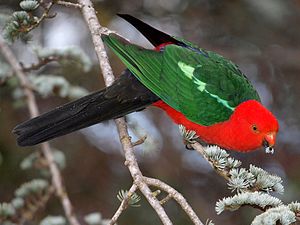King Parakeets
| King Parakeets | ||||||||
|---|---|---|---|---|---|---|---|---|

King Parakeet ( Allisterus scapularis ), Canberra, Australia |
||||||||
| Systematics | ||||||||
|
||||||||
| Scientific name | ||||||||
| Alisterus | ||||||||
| Mathews , 1911 |
The king parakeets ( Alisterus ) are a genus of the family of real parrots. There are three species in this genus.
features
King parakeets reach a body length between 35 and 46 centimeters. Compared to their body size, they have a small beak that has a smooth and waxy-looking surface. The tail is long and tiered.
Sexual dimorphism is usually very pronounced - females usually have less red in their plumage. However, there are subspecies in which the female is almost identical to the male. They are good fliers with a quick and straight flight.
Distribution area and way of life
The range of king parakeets is the east of Australia, New Guinea and the Moluccas.
King parakeets are typical forest dwellers whose height ranges from plains to altitudes of 2600 meters. In their area of distribution, they sometimes undertake annual cyclical migrations between the lowlands and the highlands.
As forest dwellers, king parakeets eat comparatively more fruit than parrots in open landscapes. Your diet also includes seeds, berries, nuts, nectar, flowers and flower buds. The King Parakeet, which occurs in Australia, can become a nuisance in gardens, where it eats tomatoes, peas and beans, among other things. To prevent crop damage, shooting permits are occasionally issued, although the King Parakeet is a protected species in Australia.
King parakeets are cave-breeders who usually seek very deep caves in old, mighty trees to breed. The clutch comprises between three and six eggs. Only the female breeds, which is fed by the male outside the brood cavity. The breeding season is between 18 and 21 days. The nestling period is between 40 and 49 days.
Systematics
The following three recent species belong to the genus of King Parakeets :
| German name | Scientific name | distribution | Hazard level Red List of IUCN |
Remarks | image |
|---|---|---|---|---|---|
| Amboina King Parakeet |
Alisterus amboinensis ( Linnaeus , 1766) |
Moluccas and the Indonesian part of New Guinea. |
|
6 subspecies: A. a. amboinensis ( Linnaeus , 1766) Buru King Parakeet ( A. a. buruensis ( Salvadori , 1876)) Salawati King Parakeet ( A. a. dorsalis ( Quoy & Gaimard , 1830)) Halmahera King Parakeet ( A. a. hypophonius ( S. Müller , 1843)) Sula King Parakeet ( A. a. Sulaensis ( Reichenow , 1881)) Peleng King Parakeet ( A. a. Versicolor Neumann , 1939) Body length up to 35 centimeters. Head, neck and underside dark red. Five subspecies have green wings, A. a. hypophonius has blue wings. Orange iris and dark gray legs. |

|
| Green-winged King Parakeet |
Alisterus chloropterus ( Ramsay , 1879) |
New Guinea |
|
3 subspecies: A. c. callopterus ( D'Albertis & Salvadori , 1879) A. c. chloropterus ( Ramsay , 1879) A. c. moszkowskii ( Reichenow , 1911) body length up to 36 centimeters. Pronounced gender dimorphism. Males have a wide blue neck band, a black-blue back and a yellow-green band on the wings. |

|
| King Parakeet |
Alisterus scapularis ( Lichtenstein , 1818) |

|
|
2 subspecies: A. s. scapularis ( Lichtenstein , 1816) A. s. minor ( Mathews , 1911) native to the east coast of Australia. Body length up to 46 centimeters. In the male, the head, neck and underside are red, wings and back are green. The rump and tail are blue-black. The upper beak is red and the lower beak is black. The female is mostly green, only the belly area is red. The beak is blackish. |

|
attitude
King parakeets and Ambroina parakeets have been kept frequently for a long time. The Green-winged King Parakeet is less common in captivity than the other two parakeets. The first breeding of the King Parakeet was successful in 1880 (Germany), the Green-winged King Parakeet in 1945 (Great Britain) and the Amboina King Parakeet in 1974 (Germany).
The King Parakeet can live up to 26 years and 7 months in captivity.
literature
- Joseph M. Forshaw : Australian Parrots. 1st German-language edition. Volume 2, Arndt-Verlag, Bretten 2003, ISBN 3-9808245-2-7 .
- Joseph M. Forshaw: Parrots of the World. Princeton University Press, 2010, ISBN 978-0691142852 .
- W. Grummt , H. Strehlow (Ed.): Zoo animal keeping birds. Verlag Harri Deutsch, Frankfurt am Main 2009, ISBN 978-3-8171-1636-2 .
Web links
Single receipts
- ^ Forshaw: Australian Parrots. Volume 2, p. 349.
- ^ Forshaw: Australian Parrots. Volume 2, p. 353.
- ^ Forshaw: Australian Parrots. Volume 2, p. 350.
- ^ A b Forshaw: Parrots of the World .
- ↑ W. Grummt, H. Strehlow (Ed.): Zoo animal keeping birds. P. 381.
- ↑ W. Grummt, H. Strehlow (Ed.): Zoo animal keeping birds. P. 382.
- ↑ a b W. Grummt, H. Strehlow (Ed.): Zoo animal keeping birds. P. 383.